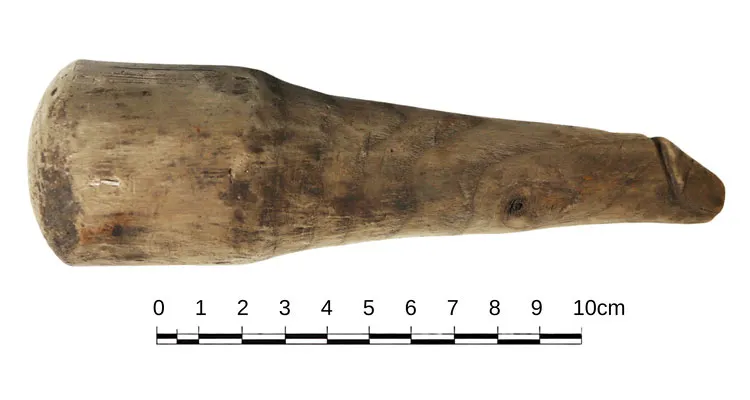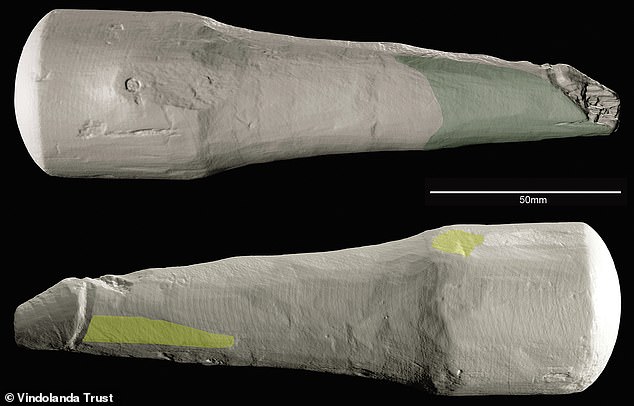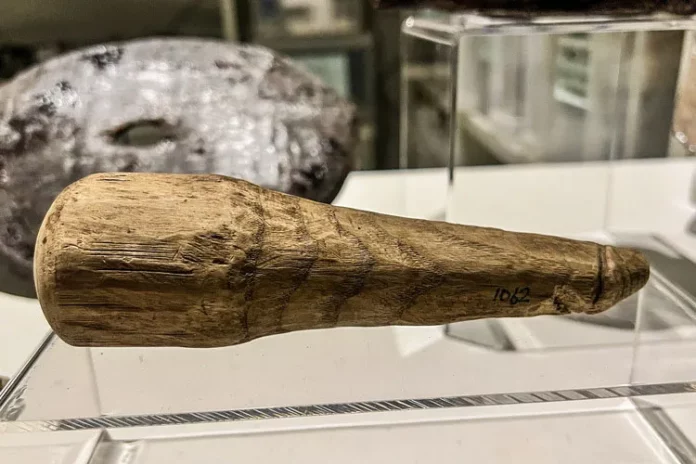In 1992, archaeologists unearthed an intriguing wooden object in northern England. Initially thought to be a darning tool due to its oblong shape and the context in which it was found—next to shoes and clothing accessories—the artifact’s true nature has recently been re-evaluated. According to a new study published in Antiquity, this 6.3-inch-long wooden piece is actually a “large, disembodied phallus.” Carved from ash wood, it was discovered at the Roman Vindolanda fort site near Hadrian’s Wall and is now on display at the Vindolanda Museum in Northumberland, England. This artifact stands as the first known life-sized wooden phallus from the Roman era.
Reinterpreting the Ancient Artifact

Initially, the object was believed to be a mundane darning tool. However, after 30 years of further study, researchers have proposed a dramatic shift in understanding. The artifact’s new interpretation has sparked considerable debate and discussion among scholars.
Rob Collins, an archaeologist at Newcastle University and co-author of the study, elaborates on the significance of this new perspective. “Often in archaeology, when we find an object, we can tell what it was used for—or deduce what it was used for,” Collins said in an interview with the Guardian. “That wasn’t the case for this object. We have had to cast our nets wide in thinking, what would a six-and-a-half-inch wooden carving of a phallus be used for? We had some very interesting discussions.”
Theories Behind the Artifact’s Use

Sexual Implement
One prominent theory is that the object was used for sexual purposes, akin to the phalluses depicted in Roman art and literature. This theory posits that while it might have had a role in sexual pleasure, it could also have been used by individuals in positions of power for more sinister purposes. Collins suggests that the phallus could have been a tool for enforcing power dynamics and subjugation.
Pestle or Magical Tool
Another hypothesis is that the object functioned as a pestle or grinder for mixing food, medicines, or cosmetics. The distinctive phallic shape might have been thought to imbue the substances with magical properties, a common belief in ancient cultures.
Good Luck Charm
The third theory suggests that the phallus may have been part of a statue situated near the entrance of a significant building. It’s conceivable that people would touch or rub the item for good luck as they passed by. However, this theory is less supported, given that the artifact shows no signs of outdoor exposure or weathering.
The Value of Reexamination

Regardless of its actual use, the reexamination of this artifact highlights the importance of periodically revisiting past discoveries. New interpretations can provide fresh insights into historical objects and their roles in ancient societies.
Barbara Birley, curator at the Vindolanda Trust, reflects on the significance of the find: “The wooden phallus may well be currently unique in its survival from this time, but it is unlikely to have been the only one of its kind used at the site, along the frontier or indeed in Roman Britain.”
Conclusion
The 6.3-inch wooden phallus from Vindolanda has challenged previous assumptions and opened new avenues of inquiry into Roman artifacts. Whether used as a sexual implement, a magical tool, or a good luck charm, its discovery and re-evaluation underscore the dynamic nature of archaeological research. As scholars continue to explore the context and significance of ancient objects, our understanding of history remains ever-evolving.
